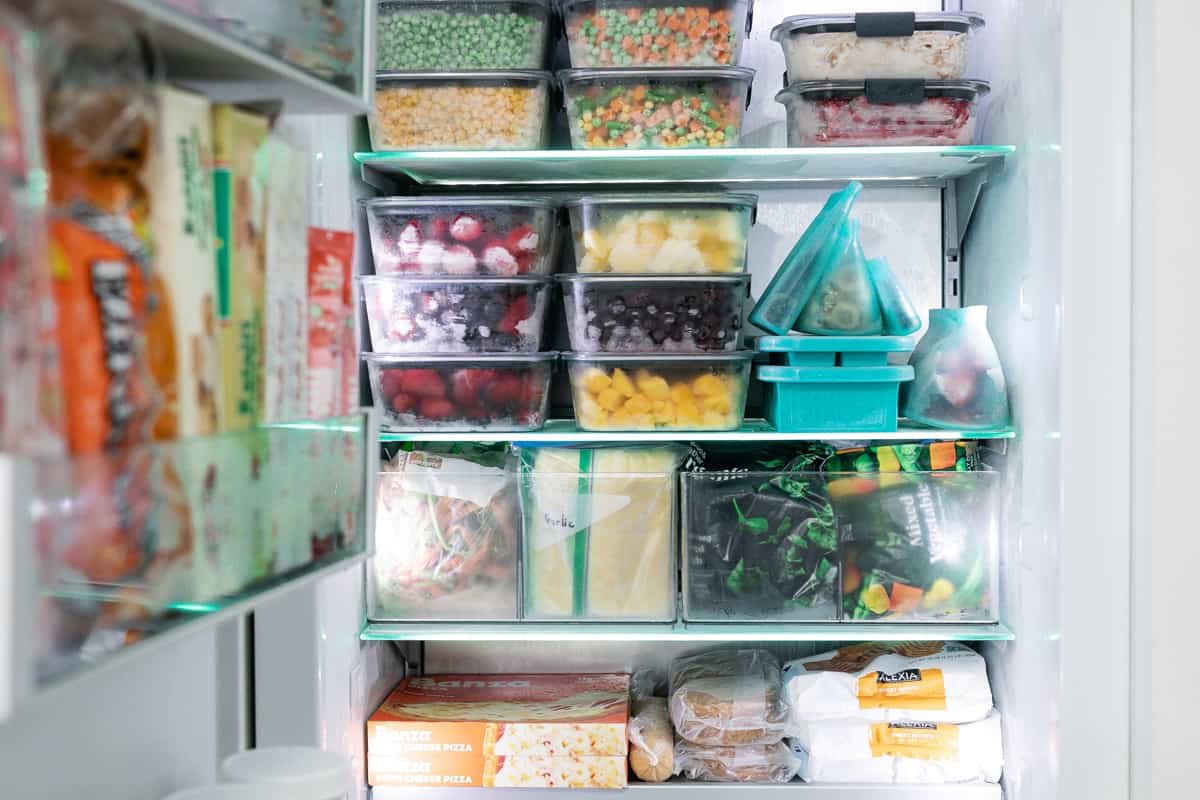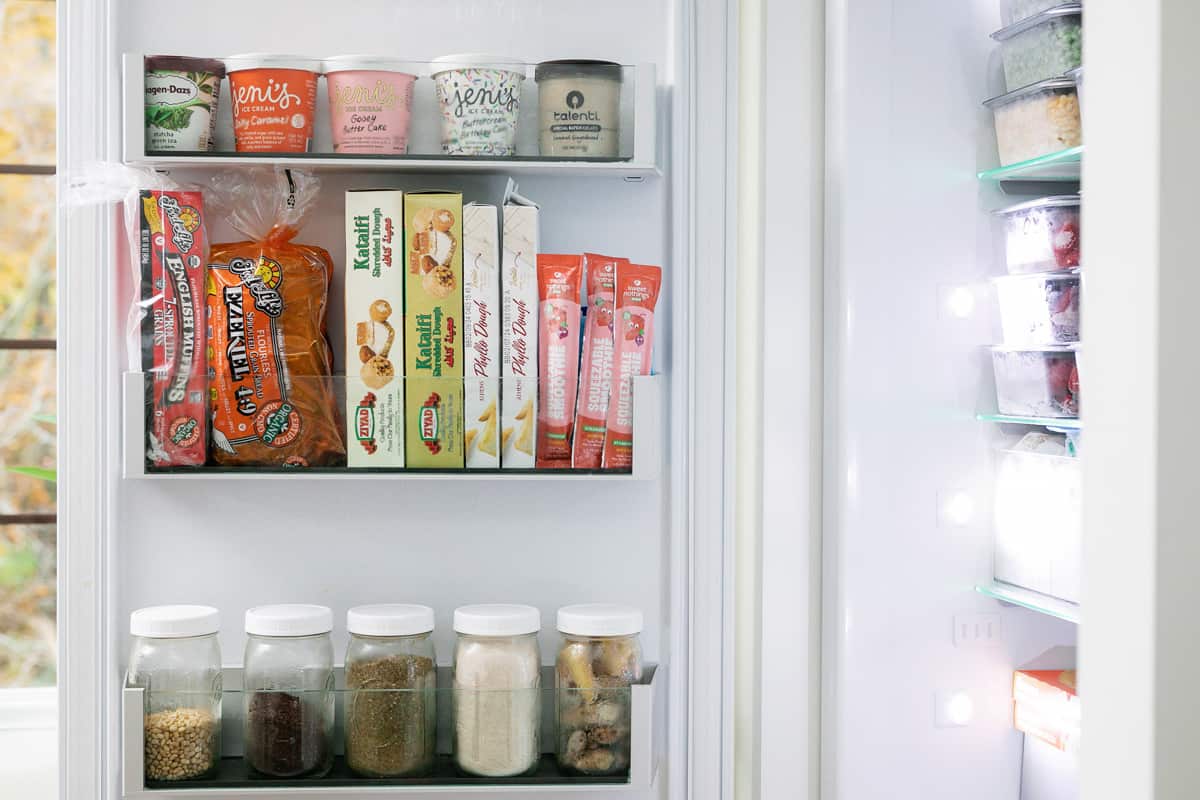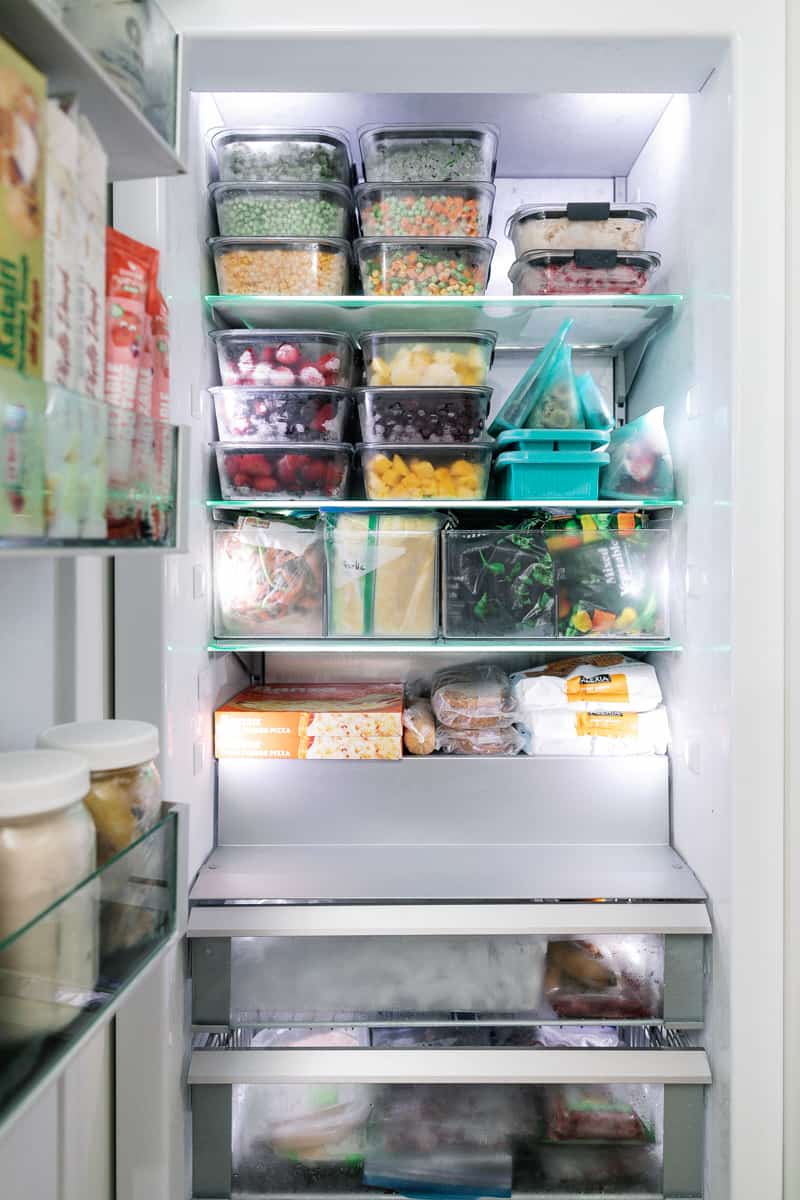This post may contain affiliate links. Please read our disclosure policy.
With the spread of the coronavirus and the possibility of sheltering in place, we are all thinking about how to stock our pantries and freezers with supplies to last a few weeks or at least cut down on trips to the store. Below is a list of items I always have stocked in my freezer. Just like having a well-stocked pantry, keeping ingredients in the freezer can help you make a quick and healthy meal in a pinch.

Table of Contents
With few exceptions – notably creamy things, soft cheeses, lettuces – almost everything can be frozen. If you don’t see something specific below that you’re interested in freezing, please leave a comment and I will address it 🙂
Tips for how to stock your freezer
Before diving into the list, here are some things to keep in mind as you’re stocking your freezer.
- Invest in a thermometer: The FDA standard dictates keeping your freezer at 0˚ Fahrenheit or lower. Pick up an inexpensive refrigerator/freezer thermometers for some cheap insurance that all is well.
- Wrap it right: The label “freezer” on plastic bags, food wrap, or containers indicate that they can stand up to cold temps, keep moisture out, and flavors in.
- Check your glassware: Freezing in glass? Choose canning jars that are made from tempered glass or containers marked “freezer safe.” Leave at least an inch at the top for expansion.
- Think squares and rectangles: If you have a choice, square containers will stack more efficiently. Fill freezer bags efficiently by filling them laying flat on a baking sheet to freeze into thin rectangles that can be stacked – unlike blobby water balloon shapes.
- Portion it out: Portion as you would use, i.e. if you bring home a 12-pack of boneless skinless chicken breasts but tend to cook only four at time, freeze in four-packs. Smaller packages defrost more quickly as well.
- Room to breathe: When initially freezing something like a big lasagne, give it space so cold air can circulate around it and freeze it quickly. Once frozen, then, food can be packed in closer together.
- Label and date. This will come in handy for keeping in my expiration dates. Most items can be frozen for up to 3 months, and others longer as indicated on packages. And, if you have a big freezer consider keeping a separate list of what’s in there.
- Limit air exposure. This will help prevent freezer burn. If you’re freezing items in bags, remove as much as possible before sealing. If possible, double wrap items by first wrapping in plastic or aluminum foil and then placing in a a freezer-safe container.
- Don’t refreeze anything that was thawed once. The quality of the item just degrades and in some cases with meat and poultry, it could introduce bacteria to the food.
- When in doubt check: The FDA and the National Center for Home Preservation are all authoritative resources for food safety questions.
Freezers items to purchase
Meat, poultry, seafood
Buying from the frozen aisle? Throw those packages right in your freezer being mindful of use-by dates. Vacuum-packed items are also ideal for freezing. Meat in freezer-safe paper right from the butcher can be covered with a second layer of aluminum foil. Products packaged on styrofoam plates covered in plastic wrap are okay but should be used in about a month. Times noted below in months are for optimal flavor. Theoretically, food frozen that is stored below 0˚ can last indefinitely.
- Beef (steak, lasts 6 mos; beef strips, 3-4 mos; beef stew meat, 3-4 mos; groundbeef, 3-4 mos.)
- Chicken (breast, thighs, drumsticks – all parts good for 9 mos; ground chicken, 3-4 mos.)
- Seafood (cod, 3 mons; Mahi Mahi, 3-6 mos; shrimp, 3-6 mos, salmon, 3 mos; halibut, – 4 mos.) As a rule of thumb: leaner fish outlasts fatty fish (like salmon) in the freezer.
Fruits
When buying frozen fruit, look for bags where you can feel the individual pieces in the bag. Big frozen clumps indicate the bag may have defrosted at some point. The FDA does not have guidelines for storage limits on frozen fruits and veggies, but most foodies say use frozen fruit up within a year, if not sooner. Frozen fruit has the best texture before it is completely thawed. These are some I usually have in my freezer.
- Berries
- Bananas
- Cherries
- Cranberries
- Mangoes
- Peaches
- Pineapple
Vegetables
These are the nutritional MVPs of your freezer section and since they are frozen when picked, they are loaded with vitamins and recipe-ready. Most last about a year, so stock up on your favorites. These are the ones I mostly use in my recipes.
- Brussel sprouts
- Carrots
- Cauliflower (riced and florets)
- Corn
- Edamame
- Green beans
- Onions (peeled, chopped)
- Peas
- Potatoes (yellow and sweet potatoes)
- Bell peppers (sliced or chopped)
- Spinach
- Vegetable scraps (to make broth)

Breads and grains
From supermarket loaves to fancy bakery offerings, bread freezes so well, it is something I definitely try to buy in duplicate and freeze – room permitting. You can buy frozen rice and grains or freeze leftovers.
- Bread
- Puff pastry
- Phyllo dough
- Tortillas
Nuts and seeds
Because they could get rancid. I recommend freezing nuts that you don’t eat as often. I especially do this for pine nuts since I only reach for them occasionally in some recipes. These are the four types I usually buy in bulk and freeze to always have extras.
- Almonds
- Walnuts
- Pecans
- Pine nuts

Dairy
Not all dairy is freezer friendly. But butter and hard cheese can definitely be frozen. I like to buy a few extra packages of really nice butter when it is on sale. Soft cheeses should not be frozen, and in general freezing cheese can alter its flavor and texture. Packages of grated cheeses such as mozzarella will fare the best. They must be thawed in the refrigerator. These are the four groups of dairy I store in my freezer.
- Butter
- Hard Cheese
- Shredded cheese
- Ice cream
Pre-cooked or ready to cook meals
This could be frozen ready-to-heat meals, food items ready to be thrown into an instant pot or it could be meals that you doubled up on or made extras of to have on hand. This works really well for lasagna, breakfast egg cups, or sweet potato muffins.
Foods to freeze for later
While you can buy all of these foods already pre-frozen, there is a benefit to also freezing your own food. It could be because you have an excess amount that you can’t use up all at once.
It could be because you found a great deal on produce when it was in peak season. Or it could be in preparation for an upcoming event. Whatever the reason, see below for an outline or how to best freeze these major food groups.

Fruits
Whether you are freezing strawberries or bananas or pineapple, I recommend the same method. First, be sure to wash and cut the fruit as if you were going to be eating it or using fresh. Then place whatever you are freezing on a baking sheet in a single layer. This allows the individual pieces to freeze solid on their own instead of in a massive glob.
Now you can transfer the frozen individual pieces into a freezer container or freezer-safe bag and store for up to 3 months. This makes it easy to use a certain portion for smoothies, baking pies or making quick breads without the need to thaw a big blob of frozen fruit into a watery mess. Be sure to remove as much air as possible to limit freezer burn.
Vegetables
If you end up freezing your own vegetables, you must blanche – briefly boil and then immediately plunge into ice water – the vegetables before freezing them. Blanching banishes any bacteria and stops enzyme actions in the vegetables that can affect taste. Correct time is very important.
For green beans and broccoli florets, wash and cut as if for cooking, put in boiling water, start a timer when the water reaches a boil again, cook for exactly three minutes in boiling water, then plunge into ice water. When cool, dry and place on a baking sheet to freeze. Finally, store in a freezer bag. For more different veggies, see this chart from the National Center for Home Preservation
Grains
Almost every grain can be frozen in its uncooked state – even flour! The Oldways Whole Grains Council, a consortium of bakers and whole grain manufacturers, say the freezer life of uncooked grains is about six months.
But freezing cooked portions of rice, quinoa, or oatmeal can be a real time saver, as well. Store rice and quinoa in freezer bags. Freeze individual portions in muffin pans and then throw the oatmeal pucks in a freezer to be microwaved for breakfast.
Garlic
Garlic, the most elemental of ingredients is very cooperative when it comes to freezing in almost any form from whole bulbs to unpeeled or peeled cloves.
My favorite way to freeze garlic (complete tutorial linked) is to take four to five cups of unpeeled cloves – I buy them at my local healthfood store – and pulse them into a paste in the food processor. I then freeze in small plastic bags with one inch portions (equal to about a teaspoon of minced garlic) marked off. So easy.
Herbs
Do you ever buy a bunch of fresh herbs for one recipe and then let the rest go bad? It happens. Next time, you can wash, separate, and freeze individual stalk and leaves using the same method as freezing fruit that I shared above. Then move the frozen leaves to a freezer bag and use like fresh herbs in recipes.
Herbs, like cilantro and basil, are great done like this and added to stews, soups, and pastas. I always have frozen cilantro in my freezer for my Arabic stews. I also make herb-heavy basil pesto, which freezes beautifully.
Broth
Homemade broth elevates any dish it’s added to. Always make sure you cool the broth to room temperature before popping in the freezer. A large container of hot food can raise the temperature in the freezer and compromise the other food.
Freeze in the proportion you usually need for your favorite recipes, whether that is a quart for soup in a large mason jar. Leave at least one inch at the top for expansion. You can freeze small amounts in ziplock bags. You can even freezer smaller amounts in ice cube trays. Once frozen in the trays, transfer to larger bags so they’re all stored together. Broth should last up to six months.
Baked goods
Baked goods including cakes, quick breads, muffins, brownies and cookies freeze nicely as long as they are tightly wrapped. Defrost on the counter in their wrapping. Raw cookie dough is especially easy to freeze. Portion out the cookies, but instead of putting the baking sheet in the oven, slide it into the freezer. Store frozen cookies in a bag and cook from frozen. They will take a few minutes longer. Muffin batter works the same way. Longevity varies by recipe.
For more freezing resources:
Some of the best resources on freezing food are classic, encyclopedic cookbooks. Two great ones include:
- Better Homes and Gardens New Cook Book (Amazon affiliate)
- Joy of Cooking
A fantastic book with a section about freezing food but, also, simply a lovely, comforting source that answers any conceivable question about housekeeping in general, is Home Comforts. Author Cheryl Mendelson’s introduction will make you feel good about life.
For more cooking resources:
- How to Stock your Pantry
- 16 Pantry Meal Ideas
- 15 Easy No Bake Desserts
- 10 Recipes with Vegetable Broth
- Daily Breakfast Ideas to Stay Healthy
Whether it is cooking ahead for a big party (freeze that lasagna), saving half a batch of cookies for later, or part of your weekly meal prep, the freezer is a cook’s best friend. In a world where much is out of our control, a well-stocked freezer gives new meaning to the phrase cold comfort.
If you find these tips for how to stock your freezer useful, I’d love to hear from you! And if you snapped some shots of your well-stocked pantry, share it with me on Instagram so I can repost on my stories!
All of your kitchen tips are so helpful! I was wondering if you had a PDF checklist version of this one similar to the pantry guide. Thank you so much!
Thank you so much! I do not at the moment, but I definitely think I should make one!
Have you ever tried using silicone bags? Plastic bags are more space efficient than containers, but they produce so much waste. Opinions on silicone bags seem very mixed.
Yes, I use silicone bags too!
Hello Yumna.
You provided very helpful information on which items can be stored in the freezer, and how to store them.
Recently I made Chicken Tikka Masala (1st time ever). My recipe didn’t call for the entire can so I had some leftover.
Can coconut milk be frozen?
In general, you can freeze coconut milk, but freezing the chicken tikka masala will probably depend on what else went in to the recipe.
Very helpful tips, thank you. You can also make a ‘cilantro pesto’ and even a radish green pesto and store in the freezer. Store in small amounts for recipes.
You’re so welcome! I love that!!
Broth:
“Hot food can bring down the temp of the freezer”
Suggested edit:
Can raise the temp.
Thank you!
What a helpful post! That is full of useful information I can’t wait to dig
deep and start using these resources.
Very helpful tips. A perfect guide. Thanks.